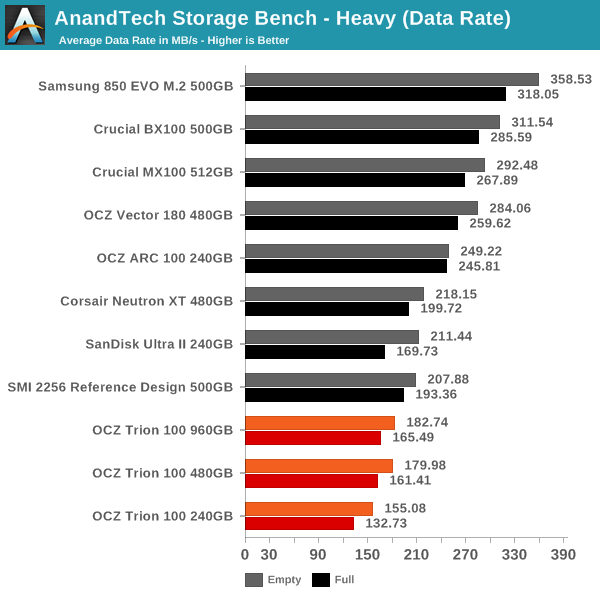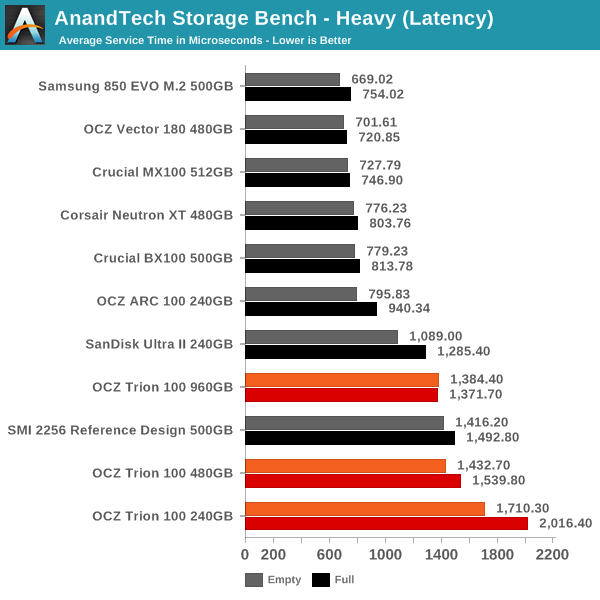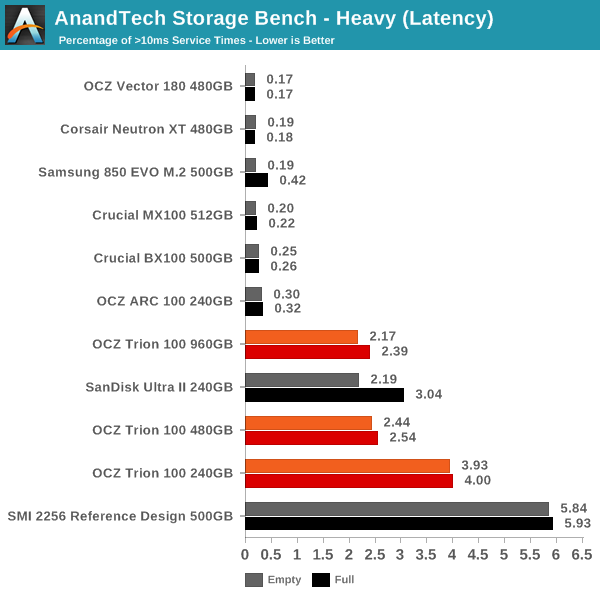OCZ Trion 100 (240GB, 480GB & 960GB) SSD Review: Bringing Toshiba to the Retail
by Kristian Vättö on July 9, 2015 12:01 PM ESTAnandTech Storage Bench - Heavy
While The Destroyer focuses on sustained and worst-case performance by hammering the drive with nearly 1TB worth of writes, the Heavy trace provides a more typical enthusiast and power user workload. By writing less to the drive, the Heavy trace doesn't drive the SSD into steady-state and thus the trace gives us a good idea of peak performance combined with some basic garbage collection routines. For full details of the test, please refer to the this article.

Ouch, this doesn't look too good. Even out of the TLC drives the Trion 100 is the slowest of the bunch and the difference isn't marginal either (~25% drop in data rate at 240GB compared to the Ultra II).

The latencies actually show a worse phenomenon as MLC based drives (even the Neutron XT) all easily stay below 800µs, whereas TLC drives start at 1,000µs and the Trion even goes above 1,500µs.

Unsurprisingly, the high average latency shows up as an increased share of high latency IOs.

Not only is the Trion slower than the rest, it also consumes more power. To be honest, I don't mind a lower performance drive if the decreased performance translates to lower power consumption, but if that doesn't happen then the whole design is simply inefficient like in Trion's case. As I've mentioned before, TLC is inherently less power efficient so increased power consumption over MLC SSDs is expected, but I still think the Trion could use some better optimization.










65 Comments
View All Comments
Samus - Thursday, July 9, 2015 - link
That isn't neccessarily true. Barefoot 3 firmware has been excellent from the beginning. Performance is good and reliability in my experience has been excellent.As far as OCZ drives go (this Toshiba drive included) Barefoot 3 drives are the only models to consider. We all know about OCZ's Sandforce firmware reliability and the Indilinx Everest has worse performance than the Marvell-based equivalent.
I still find it hard to consider drives other than Crucial MX100's and even older M500's because they are so reliable and inexpensive.
I just don't trust Samsung TLC drives, though, although quite hypocritically I am running the 850 EVO M.2 (500GB) in my laptop right now, which replaced a Crucial M550 (256GB) because Crucial's only M.2 single-sided drives in 512GB capacity are the MX200 which leaves a lot to be desired performance and power-wise, compared to the 850 EVO.
I just hope performance doesn't fall like a rock like the 840 EVO's did.
theuglyman0war - Friday, July 10, 2015 - link
hasn't it been long enough now to discern whether or not the 850 TLC suffers the same problems as the 840's? Was really hoping for a definitive follow up article by now. Or at least a community consensus. ( though I suppose it is rather cowardly to ask " did u guys blow yer money" as a research strategy :) )IlllI - Thursday, July 9, 2015 - link
I wonder when toshiba bought them out, if they were aware of the stigma of how awful the ocz line/brand of ssds were, and most people 'in the know' avoided them.Gigaplex - Thursday, July 9, 2015 - link
The stigma of OCZ isn't the only confusing part. Toshiba built their own in house SSD, why did they need OCZ in the first place?Samus - Thursday, July 9, 2015 - link
Because toshiba drives are dog slow. They have lost a lot of OEMs because of their performance. Look at the original macbook's that randomly gave customers toshiba or Samsung drives...take a guess which ones were substantially better? OCZ has indilinx which was easily worth what toshiba paid.Gigaplex - Friday, July 10, 2015 - link
And yet Toshiba opted to rebrand a Toshiba drive as OCZ, rather than the other way around.JellyRoll - Thursday, July 9, 2015 - link
You know what is REALLY amazing? This has better endurance than the 2TB 850 Pro, which is only .04 DWPD. Part of that is due to its ten-year warranty, BUT if you normalize the warranty periods the 850 PRO (and its 2bit MLC 3D V-NAND) is still not competitive with the 2D planar TLC on the OCZ. Shocking indeed.melgross - Thursday, July 9, 2015 - link
Don't make the error of confabulating "endurance", which is really no more than a theoretical number, with reliability. Samsung g's drives have, for the most part, proved to be reliable whereas OCz's have not.In fact, a problem here is that Toshiba has had their own reliability problems.
These tests don't tell us anything about that, as Anandtech has been enamoured with OCZ going way back, despite all of their problems. I'm disappointed they're even bothering to talk about OCZ until their reliability in the field is proven after the purchase. Otherwise, it's just more wasted time and energy.
Samus - Thursday, July 9, 2015 - link
Samsung drives have proven to be reliable, in that they don't fail, but they have also proven to have what is being covered up as a technological manufacturing defect dating back to the TLC-based 840 EVO that literally destroys the performance of the drive. The chill factor is Samsung A) initially ignored the issue, GM-style B) failed to fix the issue twice over 9 months of firmware updates and C) is now back to ignoring the issue, GM-style.At least OCZ published routine firmware updates, honored their warranties, and provided competitive prices.
kpb321 - Thursday, July 9, 2015 - link
I think the big issue with the 850Pro is that the warranty and rating on the drive is more about targeting a specific market rather than the actual performance of the V-NAND. The drive should be capable of much higher endurance. MLC V-NAND should have a much much higher endurance than TLC as it is trying to store fewer bits per cell and is a step back in lithography size making the cells bigger. Maybe Samsung is using some really low quality V-NAND in the 850 pro but I think it is really about "targeting" the drive at the consumer market rather than the data center.